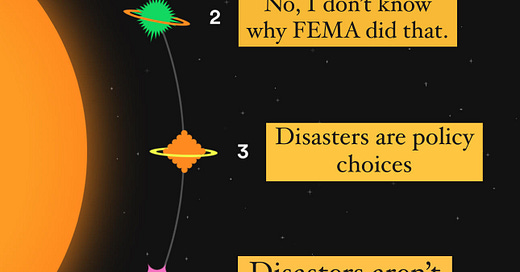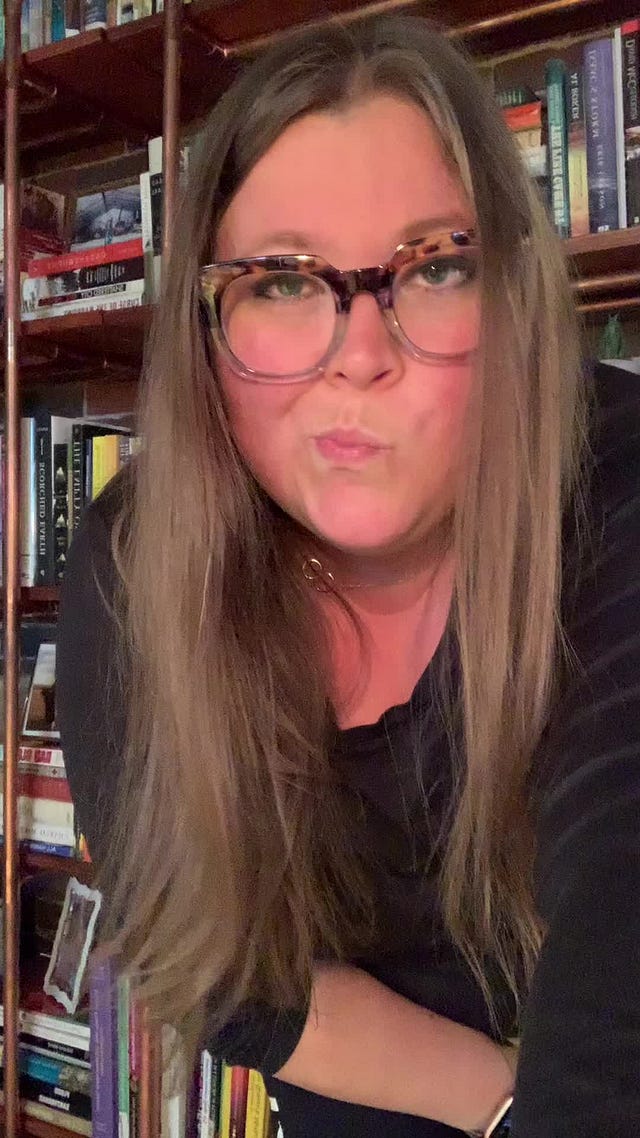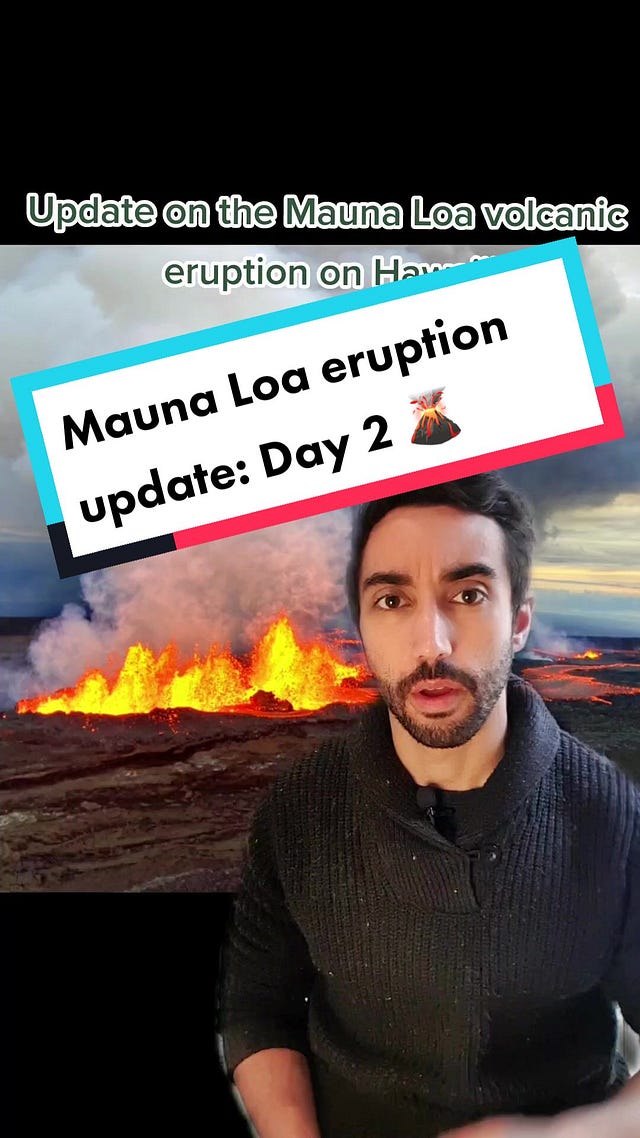Disasterology: November 2022
This newsletter is a compilation of recent disaster ~things~ that I think are cool, important, or otherwise of interest to people who are intrigued with disaster (broadly defined).
There’s a little something for everyone!
The State of Emergency Management
The state of emergency management is just trying to make it to the end of the year. This month an earthquake in Indonesia killed hundreds. Mauna Loa, the world’s largest active volcano, is erupting in Hawaii. We started and ended the month with tornados across the south. Among the numerous mass shootings this month the massacre at Club Q, an LGBTQ nightclub, highlighted the consequences of republican politicians’ anti-trans rhetoric.
Joining Disaster TikTok
I’m still wrapping my head around Disaster TikTok so I’m just going to write aloud at y’all.
I’ve been a TikTok observer since late 2019. I worked diligently to stay off “Disaster TikTok”. The clock app was my one little place where there was no doom and gloom. Just vegetable gardens, charcuterie, unattainable interior design, and good vibes.
In April, when Musk first announced he wanted to buy Twitter, I was confronted with my long-held worry that I needed redundancy in my online presence. I started to think more seriously about what it might look like to start actually making TikToks. I had some initial ideas like this one:
However, in an effort to maintain some semblance of peace, I settled on sharing my disaster book collection which is quickly nearing 1000 strong. It’s disaster-related but is lower stakes than most disaster content. Peace, y’all, I need a place that is peaceful.
When the Great Twitter Meltdown of 2022 started, I finally decided it was time to activate the contingency plan.
 Tiktok failed to load.
Tiktok failed to load.Enable 3rd party cookies or use another browser
In addition to making videos, I’ve also been deep diving into Disaster TikTok and I think I’ve got a grasp of the overall landscape which may be of interest to any of you looking to join the app.
Disaster TikToks seem to fall into the following categories:
Disaster As Spectacle. When you search “disaster” the videos that come up first are all primarily what we would traditionally call “disaster porn”. Videos of disasters unfolding in great spectacle. Not surprisingly, these are capturing most of the views and interactions.
Livestreaming Disaster. These videos are distinct from “disaster as spectacle” as they feature people who are currently experiencing a disaster. The most recent major display of this in the US was during Hurricane Ian. There were hundreds (thousands?) of videos from Florida that went viral showing how people were reacting to the storm. So much so that the absolutely cursed term “natural disaster influencer” was suggested. While there were plenty of examples of people posting effective and appropriate decision-making, of course, the videos of people making dangerous choices were the most popular.

Disaster Prep. There are an endless set of videos of folks making preparedness kits. These range from dollar store kits to full-on preppers.
Conspiracy Theorists. Don’t worry, the FEMA camp conspiracy theorist have reserved their corner of Disaster TikTok. The video format certainly facilitates their ability to share their visual “evidence” in a way that seems more effective than Twitter. So, that’s something to be concerned about.
Formal Emergency Management Presence. There are a handful of emergency managers who are posting their day-to-day or making short videos about key emergency management concepts. There seem to be less than a handful of emergency management agencies that are posting. The two big ones are Ready Harris and NOLA ready. Their followings are still small but they’re both charting a path for other agencies. Of course, there is a long list of reasons that EM agencies are hesitating to join — the time commitment and lack of resources to do it well and the obvious security concerns. Despite those challenges, I strongly believe more agencies need to have a presence there. The misinformation is rampant and there’s a real vulnerability in not having official voices in the place where so many people are getting their information. There’s also a huge opportunity to reach the public. The Oklahoma Department of Wildlife is the gold standard for how to do this.
The Hazard Scientists. I have yet to find any other disaster researchers who are making TikToks (if you are please find me and let’s be friends) but there are a bunch of hazard scientists!! They are certainly the most reliable disaster sources there at this point. Dr. Wendy Bohon is all over the earthquakes and Chris Gloninger has the meteorology issues covered. Volcanologist, Dr. Samuel Mitchell has been keeping everyone updated on the Mauna Loa eruption.
News Coverage. When a major disaster happens the news agencies on TikTok will mention it but it seems to be quite minimal and isolated to the immediate response. I don’t see that they’re actively working to use TikTok as a way to spread life-saving information, unfortunately.
Disaster Survivors. There are a handful of people who are sharing their experiences navigating the recovery process. Specifically, it looks like they’re posting videos about what it’s been like having to navigate FEMA assistance and insurance. There are also some DIY recovery-type videos.
NYC Nuclear Ad. The videos about the NYC Nuclear preparedness video are nearly a genre all their own. It just went straight to the heart of the zeitgeist. Incredible. (This is really part of a bigger category about videos that react to current disaster events.)
Dark Humor. Disaster comedy is risky. The ones I have in a thread here, are quite brilliant and can be used as a way to process a disaster, educate, or used as a tool to call out important power dynamics. We should do more of this. Relatedly, Dr. Sara McBride and Dr. Jessica Ball have an excellent research article published in the International Journal of Disaster Risk Reduction about how humor can be used by science agencies during crisis to create connection, empathy, and compassion.

I know some of you have been considering a move to TikTok. Hurry up! It feels a little lonely there right now. It would be great to have a whole bunch of really strong disaster voices on #EMGTikTok.
Meme Break
Speaking of disasters… It’s Spotify Wrapped Week and whew.
Important Disaster Media Coverage This Month
Let’s do a monthly check-in on DHS. *checks notes* A new internal report found the Department, in the words of Gizmodo, “tried to manufacture fake terrorists for Trump”. Luv 2 have FEMA associated with this kind of behavior. It’s great and surely has no negative repercussions for us.
Anyway, here’s a lovely poem titled “Disaster Means ‘Without A Star’” published in The Atlantic and there’s also a new disaster song that I’m obsessed with.
Otherwise, things have been quite lite on the disaster news front this month.
MITIGATION
Here’s Where the U.S. Is Testing a New Response to Rising Seas in the New York Times
On the edge of retreat in the Washington Post
Dream Homes and Disasters: Is the Government Ready to Confront Climate Risk? in Politico
Shelter From The Storm in Science
How to move a country: Fiji’s radical plan to escape rising sea levels in The Guardian
RECOVERY
‘On borrowed time.’ Why coastal Florida keeps rebuilding after storms like Hurricane Ian in the Miami Herald
Hurricane Ian left mountains of debris. Clearing it will take months in The Washington Post
The In Deep podcast on recovery in Lake Charles, Louisiana
PREPAREDNESS
America has an earthquake early-warning system now – on your phone in The Washington Post
Weird Disaster Thing
In 1926 a silent film about the Johnstown Flood was released becoming one of the first-ever disaster films. This movie is so old that Clark Gable is just an extra in it. Turns out it’s available in full on Youtube. I’ll avoid spoilers but it’s a journey of corporate corruption!
The End Bits
I would love it if you’d forward this to your friends, post on social media, and undertake any other form of newsletter sharing you deem appropriate.
In case you signed up for this newsletter without knowing who I am (a bold choice!) you can read my book Disasterology: Dispatches From The Frontlines of The Climate Crisis to catch up! You can read a USA Today review here, order it here, or get it as an audiobook here. You can also find more from me on my blog, listen to this episode of Ologies, or follow me on Twitter and Instagram where I impulsively narrate my every thought. And now TikTok.
Finally, this newsletter is ~FREE~. I plan on keeping it that way because eliminating barriers to disaster knowledge is important. However, I’ve created a “paid subscriber” option for $5 a month or whatever you’d like to give if you’re interested in supporting this work.






